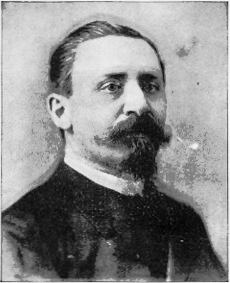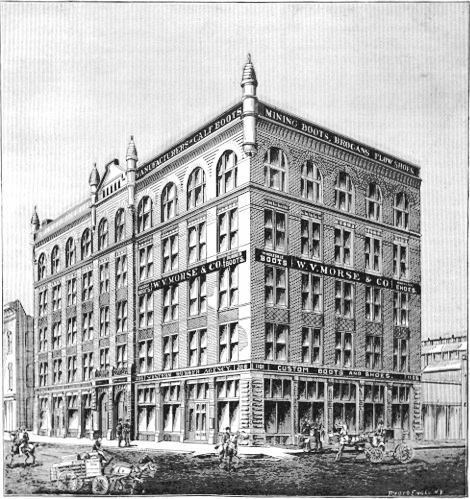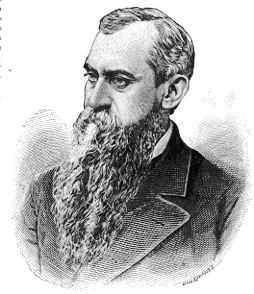|
OMAHA
ILLUSTRATED.
business footed $25,136,000. During 1886
there were 196 firms, and they did business amounting to
$35,496,000. In 1887 the number of firms reached 240, and
the business approximates $50,000,000. The leading lines
rank: groceries, lumber, dry goods, steam supplies,
hardware, coal, liquors, boots and shoes, drugs,
agricultural implements, furniture, leather and hides,
besides twenty or more lesser lines. The profits in the
whole
|
[Mr. Peter E.
Iler is one of Omaha's most prominent and
successful business men. He is a native of Ohio,
having been born at Wooster, February 10, 1840. At
the early age of sixteen he began to earn his own
living by doing chores for a banker of
Indianapolis. He was soon given the superintendence
of his several farms, and his salary was raised
from twenty to seventy-five dollars a month.
Becoming sick he returned to his home at Tiffin,
and upon recovering his health he started out as a
country peddler with a
|
|
one-horse wagon and a small stock of notions. He
met with success and soon drove a splendid
four-in-hand team and a beautiful wagon. He also
took orders for all the wholesale merchants in
Tiffin, doing in this way a large commission
business. Mr. Iler branched out and established a
general supply store, engaged in the manufacture of
cigars, and ran a distillery and a general liquor
store, all of these enterprise proving successful.
The railroads entering Ohio materially decreased
Mr. Iler's trade, and he decided in 1866 to locate
in Omaha. Coming to this city in that year he
secured papers for a class B bonded warehouse, and
made a contract for the erection of a building in
Central Block. At that time Boyle, Miller &
Co., of Cincinnati, were his partners. He closed
out his business in Tiffin in the fall of 1867 and
moved to Omaha. Immed-
iately after the great fire in Cincinnati he bought
out his old partners and took in as
|

PETER E. ILER.
|
new partners M. W. Kennard, and his brother J.
D. Iler. The Willow Springs Distillery having been
confiscated by the government, was offered for sale
in 1870, and it was bought in the name of James G.
Megeath and P. E. ller, the partners in this
enterprise being Megeath, Iler and John McCormick.
In 1872-3 the distillery became the property of P.
E. Iler, J. D. Iler, and M. W. Kennard, the last
named gentleman remaining in the firm until 1878,
when he sold out to his partners. In 1885 Mr. Henry
Suessenbach became a partner. The distillery has
been enlarged from year to year and improved in
every way to meet the demands of trade, and today
it is the third largest distillery in the country.
Its present capacity is 12,000 gallons of finished
goods per day. The increase of business is shown by
the following figures: In 1878 the government tax
was nearly $150,000, in 1879 it increased to
$721,000, and it is now over $2,000,000.
|
|
The sales of the Willow Springs Distillery and
Iler & Co., combined, have increased in the
same ratio -- from $500,000 per annum to nearly
$3,000,000. The cost of material used in the
distillery during 1886 was $250,000, representing
510,000 bushels of grain. Over 10,000 tons of coal
were consumed. Employment is given to 125 men. The
annual pay-roll is over $80,000. Mr. Iler was one
of the original organizers of the South Omaha Land
Syndicate, which has resulted in making this city
the third pork packing center of this country. He
has for some time been the leading spirit in the
movement to solve the cheap coal problem, he and
his associates having already spent a considerable
sum of money in boring for a paying vein of coal.
He is also interested in the effort that is being
made to discover natural gas in this vicinity. He
is a member of the National Distillers'
Association, and a prominent member of the Omaha
Board of Trade. In 1863 Mr. Iler was married at
Tiffin, Ohio, to Miss Mary A, Denzer. They have
four children living - William E., May, Edith and
Bessie. Mr. Iler is a home man, taking great
delight in his interesting family, and doing
everything in his power to make home happy for
them.]
|
sale and jobbing trade have been large. Not a failure has
been recorded, and most of the firms have increased their
capital to keep pace with the growth of their trade. The
retail trade, too, as may well be imagined in a growing city
of 120,000 inhabitants, has been prosperous, but any figures
regarding its volume or the number engaged in it would be
valueless to the purpose of this work. Suffice it to say
that the enterprise of its merchants and the conveniences
afforded in railroad facilities to the people of Council
Bluffs, Lincoln, Plattsmouth, Fremont and other neighboring
towns, have greatly increased the retail trade of the
city,
[72]
|


